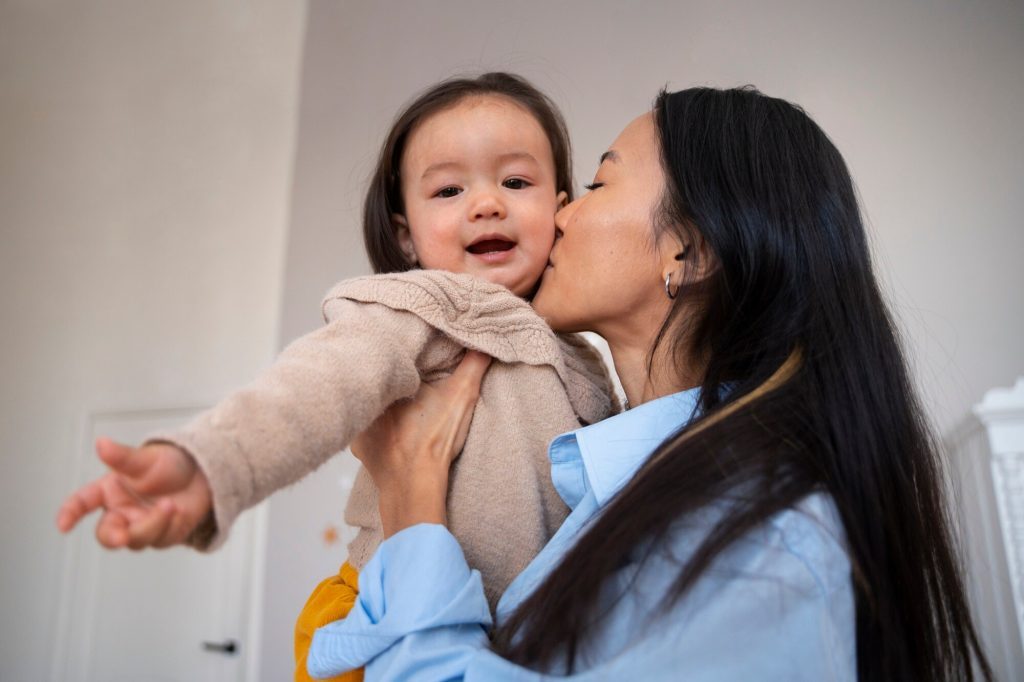Why is it that some children are so clingy with their parents, while others pretend like their parents don’t exist? Attachment Theory explains how we form and maintain relationships with others, starting from infancy to adulthood. Children begin to develop their attachment style the moment they are born, and their first relationships are formed with their primary caregivers. Attachment Theory tries to explain different types of attachment styles, how they form, and how they influence us later in life. Nowadays, Attachment Theory is so popular in the parenting discourse that people may be implementing attachment strategies without even knowing it.
The Four Attachment Styles
Attachment Theory was first proposed by John Bowlby in the 1950s, and further explored by Mary Ainsworth in her hallmark “Strange Situation Test” in the 70s. Attachment styles begin forming in infancy (0–3 years old) when babies interact with their primary caregivers, and can be categorized into four types – secure, anxious, avoidant, and disorganized.
Anxious Attachment
What causes children to form an Anxious Attachment style?
Anxious attachment stems from inconsistent and erratic caregiving, especially when their baby’s needs are not being met. Caregivers may sometimes be attentive to their baby’s needs and at other times be distracted or distant, leaving their baby feeling insecure about whether or not they can rely on their caregivers. On the other hand, caregivers who are overprotective can also induce anxious attachment styles since it can make their baby feel like they need constant reassurance.
Traits in early childhood
Anxiously attached children exhibit intense insecurity and clinginess. They hesitate to explore their surroundings, react strongly to separations, and are scared of being abandoned by their caregiver. They are hypersensitive to criticism or discipline, constantly worrying about losing their caregiver’s love.
Traits in Adulthood
As adults, individuals with an anxious attachment style are fixated on securing love from others, and often struggle with low self-esteem and insecurity. Anxiously attached individuals may attach quickly onto their partner and show signs of over-dependence, constantly needing to be reassured (e.g. “Do you still love me?”). They may be hyper-vigilant of their partner and read into all of their behaviors (e.g. slow at responding to texts, suspicious of other friends, etc.) as signs of rejection or abandonment.
Avoidant Attachment
What causes children to form an Avoidant Attachment style?
Avoidant attachment stems from dismissive parenting styles. When caregivers ignore their child’s cries for comfort or are emotionally cold (e.g. doesn’t show affection), children can take that as a sign that they cannot rely on others for help. Additionally, caregivers who actively discourage or punish children from expressing their feelings (e.g. saying “stop crying like a baby” or “big girls/boys don’t cry”) can also induce an avoidant attachment style, as children believe that expressing emotions and being vulnerable only gets them in trouble.
Traits in Early Childhood
Avoidant children may appear independent on the surface, but they are actually emotionally detached. They often suppress their emotions and needs to avoid drawing attention from their caregivers, and prefer to rely on self-soothing rather than seeking comfort from others.
Traits in Adulthood
Adults with avoidant attachment styles may come off as very independent and self-sufficient. In reality, even though they seem ‘fine’ on the surface, they could be internally distressed. In relationships, this can play out as being emotionally distant, avoiding physical affection or avoiding commitment. They may shut down during conflicts or vulnerable conversations, and may be overly logical about the way they analyze their feelings instead of actually ‘feeling’ them.
Disorganized Attachment
What causes children to form a Disorganized Attachment style?
Disorganized attachment is the most complex of the four, and often arises from traumatizing or frightening experiences in early childhood. When caregivers are both the source of safety and fear, children become confused about how they should feel and react to their caregiver, which results in confusing and chaotic behavior. For example, if a caregiver sometimes soothes their child, and at other times threatens them for crying or completely neglects them, the child will become confused about whether or not their caregiver is a source of comfort or fear.
Traits in Early Childhood
Children with a disorganized attachment style may display contradictory behavior. For example, they might crawl towards their caregiver and suddenly freeze or turn away. They may have confusing responses to distress, such as sometimes lashing out aggressively, and other times being completely helpless and ‘spacing out’. They may show fear towards their caregivers, but continue to feel attached even in abusive situations. All in all, their behavior can be characterized as inconsistent and unpredictable – hence the name ‘disorganized’ attachment.
Traits in Adulthood
Adults with a disorganized attachment style are similar to children in the sense that they are inconsistent with their needs. They may cycle between feeling intense closeness with their loved ones and pushing them away. They sometimes fear being too close to others, but at the same time also struggle with fear of abandonment. They may also freeze in times of distress, and become emotionally detached. Overall, their behaviors and emotions come off contradictory and confusing for those around them.
Secure Attachment
What causes children to form a Secure Attachment style?
A secure attachment is the result of consistent and reliable parenting. When caregivers reliably respond to their baby’s needs and cries for comfort, validate their feelings, and provide unconditional love, children feel safe and are able to form a secure attachment style. Importantly, the caregivers themselves are usually also securely attached to their partner and those around them, as children are always observing their caregiver’s behaviors and emotions.
Traits in Early Childhood
Securely attached children explore their surroundings confidently when their caregivers are present. They may feel anxious or distressed in new situations or when their caregivers are gone, but they quickly calm down and seek reassurance when their caregiver returns. Securely attached children have high self-esteem, but will still seek help when they feel distressed, as they believe that they can rely on others around them.
Traits in Adulthood
Adults with a secure attachment style are able to form stable relationships, feel comfortable with intimacy, trust others appropriately, and can regulate their emotions effectively. They can be vulnerable without fear of rejection or abandonment, and are not overly clingy and suspicious of their partner. They tend to have high emotional resilience, and can bounce back from conflict or stressful situations. Lastly, they also often have high self-esteem, without excessively needing external validation from others.
The Strange Situation Study
In 1978, psychologist Mary Ainsworth set out to examine how children actually react in a stressful situation – this hallmark study became known as the “Strange Situation” study. Children were placed in a new environment with their caregiver, and researchers observed how the children reacted when their caregiver left for a brief period of time. After a few minutes, their caregiver returned, and researchers further observed how children reacted.
| Attachment Style | Reaction during the “Strange Situation” study |
| Secure | Cries when their caregiver leaves but calms down after they return. They seek comfort and then return to playing on their own. |
| Anxious | Cries intensely when their caregiver leaves and is unable to calm down after they return. Clings onto their caregiver and does not continue playing on their own. |
| Avoidant | Shows little reaction to their caregiver leaving but is likely internally distressed. Does not seek comfort when their caregiver returns. |
| Disorganized | Displays erratic and unpredictable behavior when caregiver leaves and returns, alternating between seeking and rejecting their caregiver’s comfort. |
Attachment Style Quiz: Which Attachment Type Does This Child Have?
Test out your newly acquired knowledge of the different attachment styles with this simple quiz. See if you can correctly identify the child’s attachment style from this scenario.
Scenario
Lily (4-years-old) is playing at the park with her mom and aunt. Mom steps away for a minute to grab something from the car. Lily looks back and doesn’t see her mom anymore, she begins to panic. She runs over to her aunt. “Where is mom?” she asks. “Mom is getting something from the car and will be back soon. Don’t worry, just go and play,” her aunt replies. Lily refuses to play and insists on waiting for her mom to come back. When mom returns, Lily gives her a big hug. “I just went to get some water,” Mom explains, “I’m not going anywhere, why don’t you continue playing with your friends?” Lily smiles and continues playing.
What is Lily’s attachment style?
Answer: Secure attachment.
If Lily had an Anxious Attachment Style, how would this scenario play out differently?
Lily would likely overreact to her mom disappearing. Even though her aunt told her Mom will be back soon, Lily would not feel comforted and insist on seeing her mom now. After Mom returns, Lily would unlikely continue playing and cling onto Mom.
Want to learn more?
We recently hosted a seminar and workshop for our TT parents with a therapist guest speaker. Watch the full seminar to learn more about attachment theory and how to foster a secure attachment with your child!
Conclusion
Attachment styles describe how we form close relationships with others, and can be categorized into secure, anxious, avoidant, and disorganized attachment. These patterns begin with early interactions between infants and caregivers and continue into adulthood, influencing our relationships throughout life. Building a secure attachment not only ensures that children feel safe and comfortable, it also allows them to maximize their early learning experiences by easily overcoming separation anxiety when they start school. The good thing is that anyone can build a secure attachment with their children, as long as you understand how each style is formed and what they are characterized by.
Reference
- J. Bowlby. Attachment and Loss Volume I: Attachment. Basic Books: New York. 1969.
- M. D. S. Ainsworth, M. C. Blehar, E. Waters and S. Wall. Patterns of Attachment: A Psychological Study of the Strange Situation. Lawrence Erlbaum: Hillsdale. 1978.
- K. E. Grossman, K. Grossman and E. Waters.Attachment from Infancy to Adulthood: The Major Longitudinal Studies. Guilford Press: New York. 2005.



